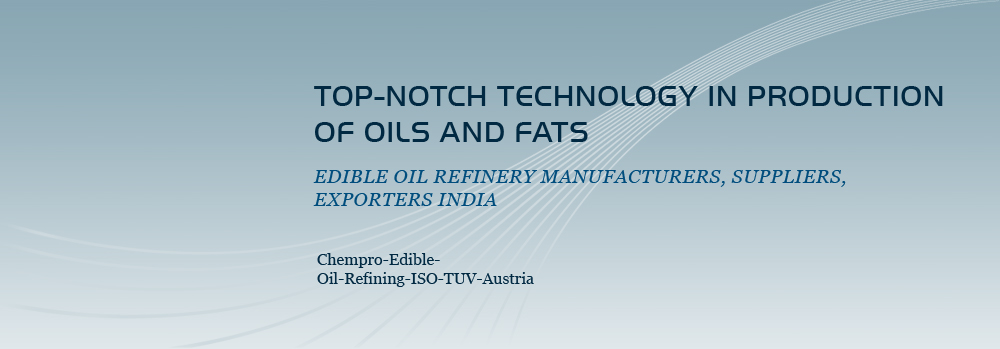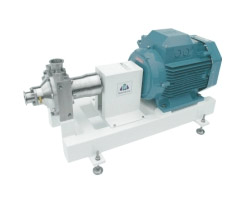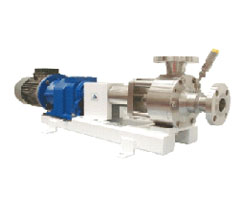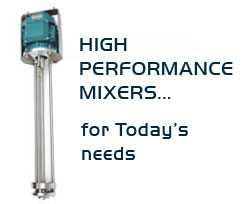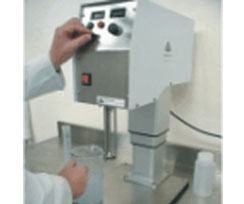Licensee Of
Maelstrom High
Shear Mixers - U.K
Our Gallery
Top-Notch Technology In Production Of Oils And Fats
Fluid Division Mixing (FDM)
FDM is a concentric rotor-stator system with indentations or cavities machines into the rotor and stator surfaces (Fig. A). The rotor and stator are based on a stepped conical form so that the diameter of the cone increases from inlet to outlet. The cavities in the rotor and stator are typically spherical segments which are open on both vertical and horizontal faces.
Medium to high viscosity fluid is pumped into the inlet of the mixing head by an external pump such as a gear pump or extruder. As fluid moves through the mixer, it is repeatedly cut and folded by the action of material transfer between the rotor and stator cavities. As there is no closure to the flowpath through the mixer and as the rotor-stator gap is normally large, the pressure drop through the head is very low. This means that highly effective blending is possible without applying shear and extensional stressing to the material. The low-shear FDM is therefore ideal for blending and conditioning shear-sensitive materials such as rubber, plastic, certain edible fats, adhesives, etc. Very good temperature control of both rotor and stator surfaces is possible using a combination of stator jacketing and internal channels within the solid rotor. This increases the range of applications still further.
Fluid Division Mixing (FDM)
TECHNOLOGY - Low Shear
Mixing Principle: Inter-Cavity Transfer
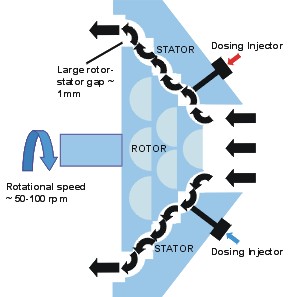 |
 |
| FDM rotor and stator | FDM mixer in Low Shear Mode shown with dosing injectors |
FDM is a concentric rotor-stator system with indentations or cavities machines into the rotor and stator surfaces (Fig. A). The rotor and stator are based on a stepped conical form so that the diameter of the cone increases from inlet to outlet. The cavities in the rotor and stator are typically spherical segments which are open on both vertical and horizontal faces.
Medium to high viscosity fluid is pumped into the inlet of the mixing head by an external pump such as a gear pump or extruder. As fluid moves through the mixer, it is repeatedly cut and folded by the action of material transfer between the rotor and stator cavities. As there is no closure to the flowpath through the mixer and as the rotor-stator gap is normally large, the pressure drop through the head is very low. This means that highly effective blending is possible without applying shear and extensional stressing to the material. The low-shear FDM is therefore ideal for blending and conditioning shear-sensitive materials such as rubber, plastic, certain edible fats, adhesives, etc. Very good temperature control of both rotor and stator surfaces is possible using a combination of stator jacketing and internal channels within the solid rotor. This increases the range of applications still further.

Benefits
The particular geometry of the FDM mixer has some particular benefits when compared to older cylindrical-type inter-cavity transfer mixers:- the stepped cavity rows allow double the number of cavity interactions for a given mixing length, making the machines more compact and less expensive
- The rotor and stator can both be made as single, externally machined or cast components rather that the "clam-shell" type of stator arrangement normally used. This again reduces cost and makes cleaning the machines easier.
- The use of quarter-spheres rather than hemispheres as cavities minimises the potential for caking and bake-on of materials within cavities. Cleanability is therefore much improved.
- The stepped cavity rows ensure that the shortest flowpath through the mixer is through the cavities rather than through the rotor-stator gap. This remedies a problem seen with cylindrical mixers where low viscosity additives are often not properly incorporated in the mixture.

